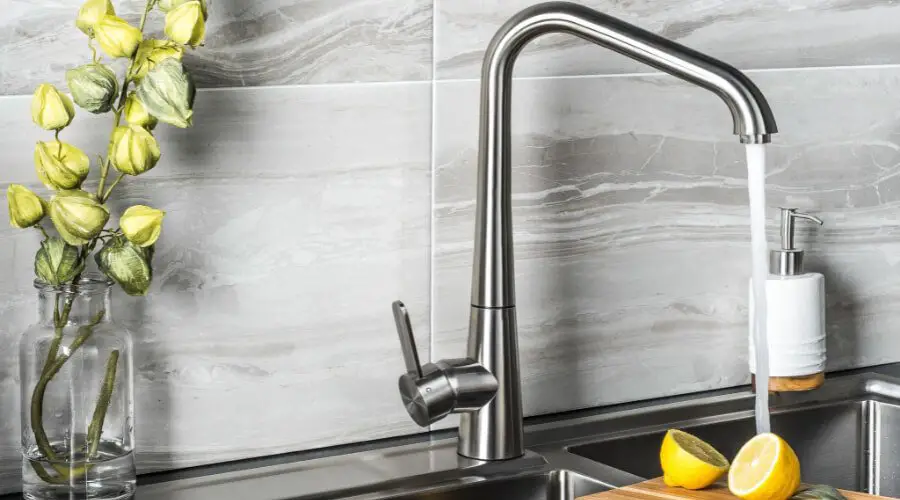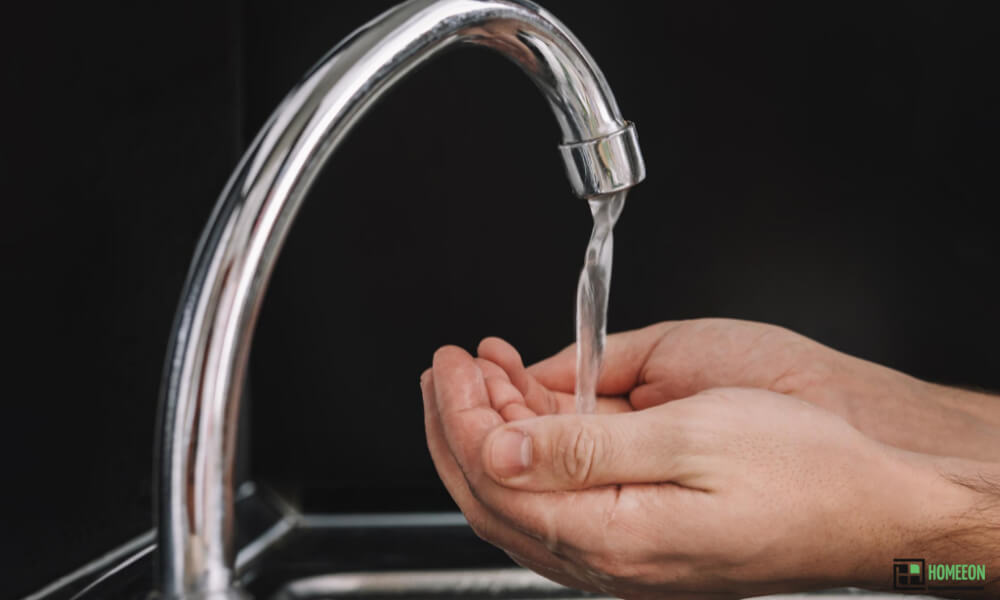Last Updated on August 10, 2023 By Emma W. Thomas
Foamy water flowing through a kitchen faucet could indicate air in the water supply. This can occur due to disruptions in the water system, such as maintenance work. Run the faucet for several minutes to clear the air. If the issue persists, contact your water provider.
What Are The Causes Of Foamy Water In Kitchen Faucets?

The reason for foamy water in your kitchen faucet can be numerous. However, it is essential to know the exact reason to find a solution to the issue.
Some of the likely causes of faucet water turning foamy or cloudy are mentioned below.
- Air bubbles
- Hard water
- Methane gas
- Total suspended solids
How to Fix Foamy Tap Water?
If you’re experiencing foamy tap water, it’s likely due to the presence of air in your water supply. This can result from various factors like maintenance work, changes in water pressure, or a disruption in the water system. While foamy water itself isn’t necessarily harmful, it’s best to address the issue. Here’s how to fix foamy tap water:
- Flush the System: Run both cold and hot water faucets in your home for several minutes. Start with the faucet closest to your water main and then work your way to other faucets. This will help clear out any trapped air in the plumbing system.
- Check for Bubbles: If the foamy water persists, collect a sample in a clear glass. Let it sit for a few minutes. If the foam disappears and turns into clear water, it’s likely due to air bubbles. If the foam remains or increases, it could be due to other contaminants.
- Contact Your Water Provider: If the foamy water doesn’t resolve after flushing, contact your local water provider or utility company. They can inform you if there are any ongoing maintenance or changes in the water system that might be causing the issue.
- Regular Maintenance: Ensure that your plumbing system is well-maintained. Sediment buildup in pipes or issues with water pressure can lead to air getting trapped in the water supply. Regular plumbing maintenance can prevent such issues.
- Consider a Water Filter: While foamy water is often due to air, if you’re concerned about other contaminants, you might consider using a water filter. A good quality water filter can help improve the overall quality of your tap water.
- Monitor Changes: Keep an eye on the quality of your tap water over the next few days. If the foamy water persists or if you notice any other changes in color, odor, or taste, it’s advisable to contact your water provider or a professional plumber to investigate further.
Are These Causes Of Foamy Kitchen Faucet Water Harmful?
While some of the causes for foamy kitchen water are harmful and should be treated immediately, some are trivial and need little to no action.
Let us discuss the harmfulness of such causes in detail with the help of a table.
| Causes Of Foamy Kitchen Faucet Water | Harmful/ Not Harmful |
| Air bubbles | Completely harmless |
| Hard water | Not harmful to health but can be a nuisance due to the residue it leaves |
| Methane gas | Harmful over a specific limit |
| Total suspended solids | Harmful as can lead to bacterial growth |
How To Be Sure Of The Probable Cause Of Foamy Water And Treat The Water From Your Kitchen Faucet?

Suppose your kitchen water is turning foamy due to one of the reasons mentioned above. In that case, you need to be sure of the cause by looking at certain signs associated with the reasons mentioned above. Only after being sure about the cause we can treat the foamy water in the faucet and make it suitable for the intended use. Also, the severity will also depend on the underlying cause.
1. Air Bubbles
Fill a glass with water from our kitchen faucet and set it aside for some time. If the water starts clearing from the bottom upwards and slowly turns completely clear, the reason is probably just air bubbles. This could happen due to recent plumbing work, increased pressure in your plumbing, or air bubbles trapped in the plumbing. The presence of air bubbles in water is common and harmless.
You can store the water in a container and leave it unattended for some time. The foam in the water will clear itself as the air bubbles escape. If the issue is trivial, then you can ignore it entirely. However, if you feel bothered by the air bubble in your faucet water, you can install a valve to eliminate the air from the plumbing. You can ask your plumber for further advice on the issue.
2. Hard Water
Hard water is another probable cause for foamy or cloudy water. Hard water is water with high amounts of minerals dissolved in it. If the terrain in your area is high in such dissolved minerals, then it is likely that the water in your faucet will be hard water. When the rainwater falls on the ground and travels to the underground reservoir, it can pick up these minerals, mostly calcium and magnesium, and become hard water.
Some signs that will help you be entirely sure are:
- White spots on washed utensils after they dry.
- You need extra detergent to wash your clothes nicely. Also, the soaps lather much slower with hard water.
- Water appliances have a coating of white or discolored residue on its surface. These are mineral deposits from water over time.
- The water never clears itself even when stored for a long time.
The high quantities of minerals dissolved in the hard water can be removed from the process of reverse osmosis. You can install a reverse osmosis filter in your house to get rid of cloudy kitchen faucet water. It will also help remove harmful chemicals and bacteria. Take your plumber’s help and advice in this regard
3. Methane Gas
Methane is an odorless gas that occurs naturally in water, mostly in the water from a well. The gas is colorless as well, so it’s hard to tell the gas’s presence in the water. Some signs can be helpful to mark its presence.
If the water from your faucet is splattering and if you spot white air bubbles in the faucet water, it could be due to methane gas.
The level of methane in the water below 7 mg/l is considered normal. However, you should monitor the levels regularly if the methane level rises. If the level of methane rises above 28mg/l, proper and instant controlling measures are required.
If you have methane gas in your water the treatment will depend on the exact level of methane gas.
You will need a professional’s help to check the level of methane gas in your kitchen faucet water.
The Required Actions Are Summed Up In The Table Below.
| Level Of Methane Gas In Water | Actions Required For Treatment And Control. |
| Below 7mg/l | No actions are required. However, constant monitoring can be useful. |
| Between 7mg/l to 28mg/l | A vented well cap needs to be installed along with constant monitoring of the level of methane gas |
| Above 28mg/l | Immediate action needs to be taken, install an aeration system to treat the water. |
4. Total Suspended Solids
As the name suggests, total suspended solids are extremely small solid particles that remain suspended in water. They remain floating and don’t settle to the bottom. The presence of such particles can make the water appear foamy or cloudy. If your water has TSS and appears very cloudy, it can lead to the growth of various bacteria in the water. Some examples of suspended solids are algae, clay, iron, manganese, sediments, etc.
If your water has TSS, it could be due to the recent construction or drilling or some other underground activity near your municipal water supply. The Suspended solids are generally cleared when they pass through a water filter.
The foams and cloudiness in your water result from suspended particles and the severity will depend on the number of suspended solids. You can get a standard cartridge installed to get rid of such suspended particles. A bag water filter can also be useful if the quantity of suspended particles and cloudiness is not severe.
However, you will need to install a multi-level water filter if the water in your kitchen faucet is too cloudy. This is due to the presence of various types of suspended particles that can be removed with the help of a multi-level filter.
These are some of the probable causes that make your kitchen faucet water foamy and sometimes unfit for use. Getting to the root cause of the issue is extremely important to understand the magnitude of the issue. Treating the foamy and cloudy water should be the next step in the process. Also, taking the help of a professional is highly recommended, as it can make the entire process much more manageable.
References:
https://houseownersguide.com/why-is-my-tap-water-foamy/
https://www.quora.com/Why-is-tap-water-foamy
Emma is a graduate of Domestic Science or Family and Consumer Sciences (Home Economics) from the University of Wisconsin. She has 7 years of experience Working with the strategic section of BestBuy and now writing full-time for Homeeon.
From Managing the Home, Interiors, Cleaning, and Exteriors to Gardening and everything about Making A Home Liveable – is her passion and this Homeeon is the result of this.
Emma loves decorating her home with the best stuff found online. She cares about quality over anything and writes reviews about them here in Homeeon. Get in touch with her over Pinterest.
Keep reading her blogs.

